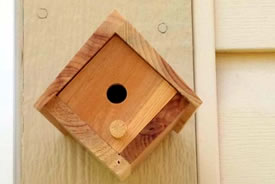How to build a bug hotel

Bee homes come in all shapes and sizes. (Photo by NCC)
Looking for a fun gardening project to help the pollinators in your yard? Why not build a bug hotel?
What is a bug hotel?
Designed to attract and shelter garden insects, bug hotels are home-made structures constructed from plant material and commonly found garden odds and ends. They can be made in a variety of shapes and sizes depending on the specific insects they are designed to host. Bug hotels provide habitat for beneficial garden insects, such as pollinators like bees, beetles and butterflies.
What kind of visitors can I expect to attract?
The insects you attract will very much depend on your local environment. Generally, bug hotels appeal to common garden insects, such as beetles, lacewings, ladybirds (also known as lady beetles or ladybugs), butterflies, spiders and much more. If it's on the ground, you might even find the occasional toad.
What are the benefits of a bug hotel?
Bug hotels help conserve local insect life by providing much-needed shelter and protection during the harsh, winter months. In addition, they make an attractive garden feature that is sure to be a conversation starter with your human guests! Finally, building a bug hotel is a great family-friendly activity and is a wonderful way to teach children about nature.
What do I need to get started?
While you can purchase pre-made bug hotels, one of the best things about building your own is that it is often at low to no cost. The required materials (typically wooden palettes, bricks and/or wooden boxes) can usually be found lying around in your garden shed. Building a bug hotel is a great way to recycle various garden bric-a-brac and put them to use in an attractive and constructive way.
You will also need to gather some plant material from your garden, such as dry leaves or twigs. Before choosing these, take the time to learn more about the specific insects you are trying to attract, as they may have particular requirements for their nesting spots. For example, if you are trying to attract ladybirds, you will need dry leaves, sticks and straw.
For a detailed how-to guide, check out this infographic from Capital Garden Services.



